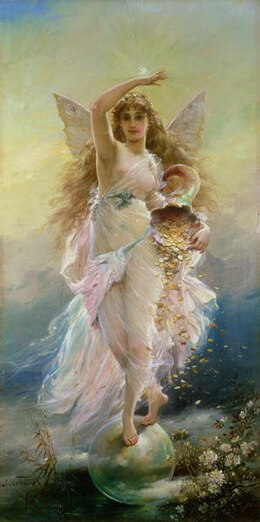إلهة


إن الإلهة هي أنثى الإله. في بعض الثقافات، ترتبط الإلهات بـ الأرض والأمومة والحب والأسرة. في الثقافات الأخرى، تتحكم الإلهات أيضًا في الحرب والموت والهلاك إضافة إلى الشفاء. قد تكون الإلهات رموزًا للأديان ويمكن التعرف عليهن في العصور الحديثة عن طريق التماثيل الدينية.
في بعض الأديان، قد يتبوأ النموذج الأصلي النسائي المقدس مكانة مركزية كبيرة في الصلاة والعبادة. في الهندوسية، تعد الإلهة المقدسة أو شاكتيسم (Shaktism) إحدى طوائف العبادة الهندوسية الثلاثة الرئيسية بجانب فيشنو (Vishnu) وشيفا (Shiva). في البوذية التبتية، أقصى طموح يمكن لأي شخص الوصول إليه هو أن يتبوأ منزلة مشابهة لإلهة بوذا «العظيمة» (مثل آريا تارا (Arya Tara)) اللائي تم وصفهن على أنهن الحاميات الأعلى، وهن لا يعرفن الخوف وتملأ قلوبهن الشفقة تجاه جميع الكائنات.
ودافعت بعض الأنظمة الأمومية الحديثة عن سيادة «الإلهة العظيمة» السماوية أو المجاورة للسماوية على أنها النسخة النسائية السابقة أو المتماثلة مع الإله الإبراهيمي (Abrahamic God) المرتبط بالظهور التاريخي للديانات التوحيدية في عصر أكسيس (Axis Age)
لدى بعض تيارات الوثنية الجديدة، وخاصة ويكا (Wicca) اعتقاد ثنوي بالإلهة الواحدة والإله الواحد، اللذين يمثلان الكيان الواحد في هيروز جاموس (hieros gamos). يركز أصحاب مذهب إعادة تأسيس تعدد الآلهة على إعادة تأسيس الديانات المشتركة، بما فيها الإلهات والشخصيات المختلفة المرتبطة بثقافات الشعوب الأصلية.
ويعد الاسم إلهة (goddess) تكوينًا ثانويًا، يجمع بين البادئة الجيرمانية الإله (god) واللاحقة اللاتينية ess. وظهر أول شاهد على ذلك في الإنجليزية الوسطى، منذ ما يقرب من 1350.[1]
انظر أيضًا
[عدل]- أنيما (يونج) (Anima (Jung))
- نوع الإله
- جينجيرا (Gingira)
- حركة الإلهة
- الإلهة الأم
- الأم السماوية
- صوفيا (Sophia)
- المغرة
- إله الأشجار
- تماثيل فينوس
- النظام الأمومي
- أسطورة ما قبل التاريخ الأمومي
ملاحظات
[عدل]- ^ Barnhart (1995:323).
المراجع
[عدل]- Dexter, Miriam Robbins, and Victor Mair (2010). Sacred Display: Divine and Magical Female Figures of Eurasia. Cambria Press.
- Barnhart, Robert K (1995). The Barnhart Concise Dictionary of Etymology: the Origins of American English Words. HarperCollins. ISBN 0-06-270084-7
- Gorshunova . Olga V.(2008), Svjashennye derevja Khodzhi Barora…, ( Sacred Trees of Khodzhi Baror: Phytolatry and the Cult of Female Deity in Central Asia) in Etnoragraficheskoe Obozrenie, n° 1, pp. 71–82. ISSN 0869-5415. (بالروسية).
| في كومنز صور وملفات عن: إلهة |
Text is available under the CC BY-SA 4.0 license; additional terms may apply.
Images, videos and audio are available under their respective licenses.

